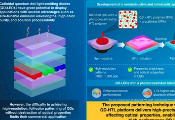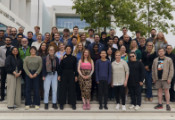Quantum Oscillations of the Lifetime
April 30 2025 -- A research team from the Technical University of Munich (TUM) and and Imperial College London has unveiled a surprising new phenomenon in the behavior of electrons in metals that could significantly deepen our understanding of quantum materials. Their discovery reveals that the average time electrons can travel before scattering—known as their "lifetime"—can vary in a periodic fashion when exposed to strong magnetic fields.
In metals, electrical currents are carried by moving electrons. However, these electrons frequently scatter off imperfections and other electrons, leading to electrical resistance. The average time between such scattering events is known as the electron lifetime.
A team of researchers has now discovered periodic variations in the lifetime of charge carriers in a metal when subjected to a strong magnetic field. This effect arises from the fact that, under a magnetic field, electrons follow circular trajectories due to the Lorentz force.
In the absence of scattering, these circular "cyclotron orbits" change in size with the strength of the magnetic field. This gives rise to so-called quantum oscillations—a periodic variation of electrical resistivity as a function of the inverse magnetic field. First observed nearly a century ago, quantum oscillations were among the earliest experimental signatures of quantum mechanics in metals. Today, they are an essential tool for probing the properties of quantum materials.
Nico Huber, PhD candidate in the group of Prof. Christian Pfleiderer, MCQST RU-E co-coordinator, and Dr. Marcus Wilde at TUM, succeeded in observing electron lifetime oscillation rather than the cyclotron motion itself. The theoretical predictions of PhD candidate Valentin Leeb in the group of Prof. Johannes Knolle, MCQST member, are in remarkable agreement with the experiment and show that electron lifetime oscillations may only be explained by electrons scattering back and forth between two cyclotron orbits.
Remarkably, the discovered mechanism has a broad range of applications for various material classes. In a subsequent review article, which recently appeared in Advanced Physics Research, the team identified a whole range of candidate materials where electron lifetime oscillations had already unknowingly been measured in the literature.
To assist future studies in the identification of electron lifetime oscillations, the researchers provide a systematic comparison to other frequency-generating mechanisms.
Their findings are expected to open new avenues for exploring the inner workings of quantum materials—substances with unusual electronic properties that are central to emerging technologies like quantum computing and ultra-sensitive sensors.
As the field of quantum technology accelerates, insights like this promise not only to advance fundamental physics but also to pave the way toward new materials with tailored electronic properties.




































